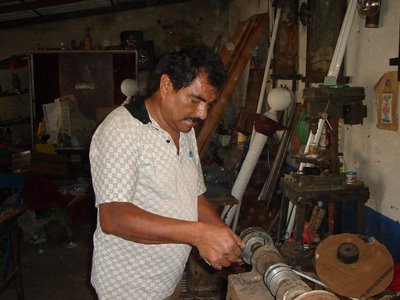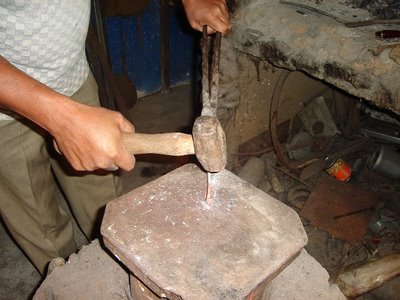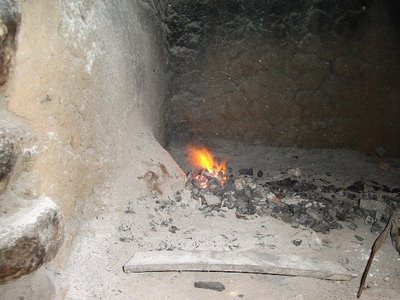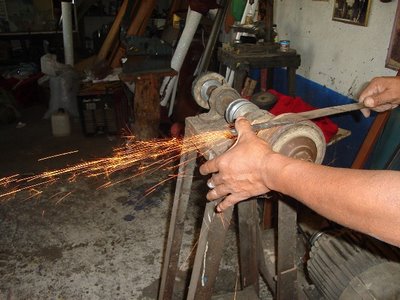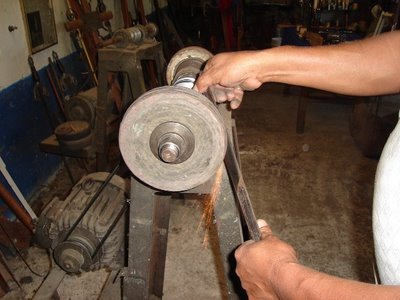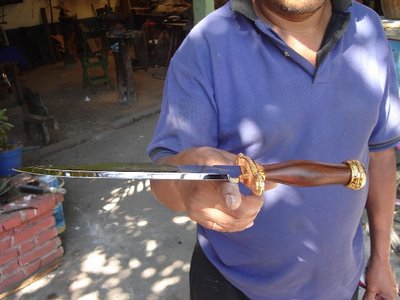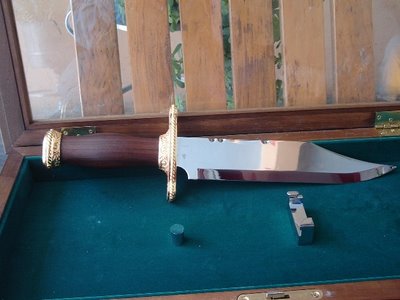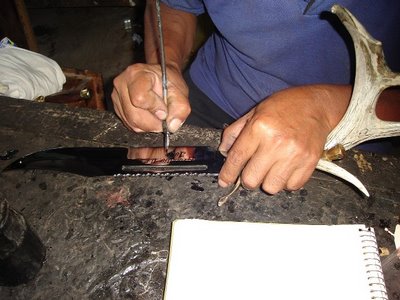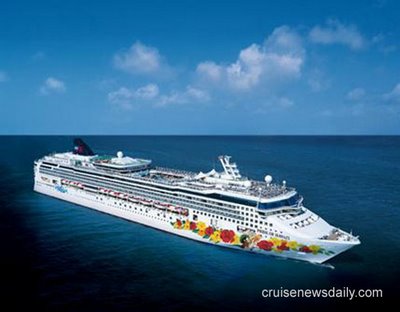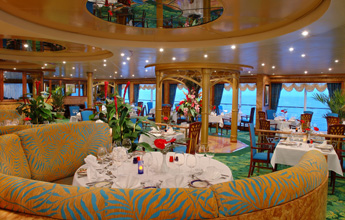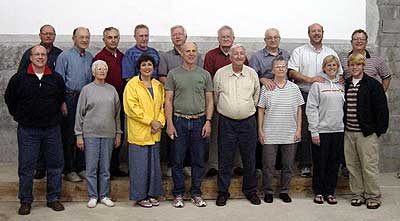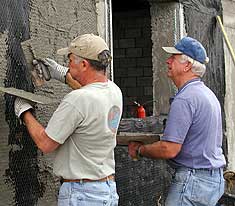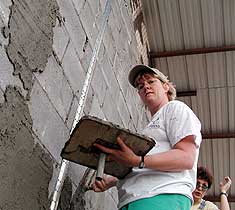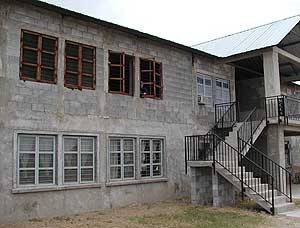This is a long and detailed post, so get a cup of coffee or pop a beer before you start. This was cross posted at
Mark in Mexico.
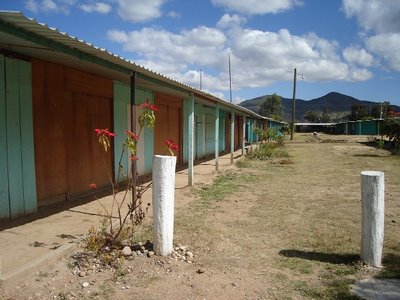 Barro negro market at San Bartolo Coyotepec
Barro negro market at San Bartolo CoyotepecPlease take a close look at the photo above. It is the Barro Negro (black clay ceramics) market at San Bartolo Coyotepec. There are about 100 stalls or booths in this market. This photo was taken at midday on a holiday. The joint should have been jumpin’. As you can see, it’s closed up tight. I found one, and only one, ceramics store open.
Only one.
The situation is just about the same all over. The artists, carvers, knife and sword makers, potters, tin artists, leather crafts makers and weavers are in terrible shape. They have begun to scatter to the four winds making them difficult to find. In an effort to sell something, many of the artists have packed up their arts and crafts, loaded them on a bus, and headed out to other states throughout Mexico chasing the tourists and gift, arts and crafts buyers who no longer come to Oaxaca.
I talked to a potter, Eloy Gómez León, in San Bartolo who told me he didn’t expect to again start seeing tourists and selling his Barro Negro until the next Guelaguetza Festival which is next July. I asked him how he expected to survive for 8½ more months and he just shrugged his shoulders. His little store is in the government market on the main highway. That’s the area where the museum, park and hotel are located, if you’ve ever been here. The museum was closed and the hotel appeared to empty. Roughly one in five of the Barro Negro stores were open in that market but I was the only visitor there.
So, what can we do?Well, we don’t need "donations". That’s not what these people want and it’s not what they need. They need to sell their arts and crafts, gifts and collectibles. The donation business is being pretty well tapped by APPO. They’ve hit Catholic churches in Southern California, the northeast and
Canada. They have received cash support from colleges and universities as well as unions, especially teachers’ unions. And they have raked in some money.
That money came in the form of cash donations. That money was used to pay transportation costs, hotel and meal expenses for their representatives who were collecting the money. Those donations were used to pay transportation and meal costs to move people from other states into Oaxaca to
march, riot and burn, except
where that transportation was provided free of charge.
Those donations were used to buy
ski masks,
rockets and bombs, slingshots, pay a 200 peso per day stipend to outsiders manning barricades all over the state, and to
buy weapons and ammunition for the
various guerrilla groups associated with APPO.
The artists with whom I cooperate have no such necessities. Their wants and wishes are far more banal. They need food, rent, clothing, raw materials for their arts and crafts, school supplies, uniforms and shoes for their kids and transportation to the markets where they would hope to find some paying customers.
They are not looking for charity. They must sell their arts and crafts to buyers of gifts and collectibles.
Mark in Mexico does not accept donations, either. That’s why you don’t see the Pay Pal button anywhere on my blogs nor will you see the ubiquitous "Please Donate" message that you see in so many other blogs. I'm uncomfortable with all that.
What can you do?Visit the
Pale Horse Galleries website. Meet the artists and their families. See the photos of some of their work. I should be kicked, punched, bitten, eye-gouged and nose-twisted for neglecting that website. This, or any website, for that matter, needs something published in it every day. I haven’t published anything there for months. We start today.
Then visit the
Pale Horse Galleries online store. The store is far from complete. Right now, the store includes alebrijes, wood carvings and some other hand made and hand painted items that should be of some interest. I have photos of some barro negro, the black clay ceramics, as well as photos of Mexico’s leading knife and sword maker at work which are not yet in the store. I’ll try to get all that done this weekend. I’ll also try to get to Ocotlan to get photos of the knife and sword maker’s work and get those into the store tomorrow night.
I’ve still got to get photos of the weavers, the ceramics makers, at least two other knife and sword makers (there are 3 different levels of knives and swords being made and 4 different levels being sold so you’ve got to watch your step), and many, many more ceramics makers. You get the idea. I need thousands more photos and then to set up the items in the store. A thousand hours of work that, in reality, will never be completed.
Let’s talk about the store and Mark in Mexico’s interest therein.I had to race through the store (twice) last week to raise prices. I was losing money on every sale. There is now a fuel surcharge being added to shipping costs because the federal government raised the price of Pemex fuels 1 peso per liter – about $0.35 per gallon US. In addition, packaging costs for boxes, foam, blister pack etc. have shot up somewhere around 20%. I don’t know if this is due all or in part to the Christmas season or not. Nevertheless, it has happened.
Here is exactly how the store’s pricing is formulated. I take the purchase price of any item and then double it. That pays my expenses and, hopefully, leaves a bit left over. San Martín Telcajete is a 45 minute drive away, 1 ½ hour round trip, and $10 US in fuel and about the same in maintenance and insurance costs for the car.
Pale Horse Galleries also needs a lot of things. We’ll talk about that in a moment. Then, depending on the item, I add 30 to 50 percent for packaging and shipping. Some items may need more.
Pay PalPay Pal is great for buyers but is a very unfriendly system for sellers. That’s because of Pay Pal’s disastrous launch. When Pay Pal first launched back in the 90’s, they took a bath. Every scam artist and fraudster from Moscow to Beijing and all points in between ripped off Pay Pal and/or its clients for millions of dollars. Pay Pal almost sunk like the Titanic. As a consequence, in addition to much polishing of its software codes, Pay Pal became just a bit harsh to deal with, from a seller's point of view.
There is still a scam going on using Pay Pal but Pay Pal has managed to protect buyers and extricate itself from responsibility to sellers (i.e.: Pale Horse Galleries). The scam is called "not as represented", among other names, most not printable. A "buyer" will order a product, pay for it through Pay Pal, wait for its delivery, then send a complaint to Pay Pal claiming that the item received was "not as represented" by the seller. When the complaint cannot be resolved between the two parties, Pay Pal will freeze the seller’s account until the dispute is resolved between both parties.
For an online business, this is a disaster. Any and all money in the seller’s account and all money entering the account are frozen. The dispute could be over a $100 item but tens of thousands of dollars could be frozen. Unless the seller has deep pockets and can afford to continue manufacturing and shipping during the dispute resolution phase, the seller is out of business. The dispute resolution phase can last up to 9 months.
So what does the seller ultimately have to do to get his money released from Pay Pal? You guessed it. Return the buyer’s money on the promise that the buyer will return the unwanted product. This, of course, never happens. So the buyer ends up with free merchandise at the expense of the seller. The only option for the seller is a criminal complaint against the buyer if the buyer can be identified and then found, a usually impossible task.
This scam got so big that a group of online sellers sued Pay Pal over it a few years ago. Pay Pal, having been burned for so many millions and having built a reputation with buyers for protecting them against unscrupulous sellers (at the expense of thousands of legitimate sellers), paid a 9.5 million dollar settlement to that group of victimized sellers rather than admit any responsibility or agree to changing any of its procedures.
Pay Pal scares me to death but, for a buyer, it’s the only game in town. And if online buyers consider it the only game in town, sellers are forced to go along.
All money transferred through Pay Pal costs me about 5%. Plus, I have discovered to my chagrin that the exchange rates used by Pay Pal and/or my bank (HSBC and Scotia Bank) here in Oaxaca are below the local exchange rate by about .35 pesos per dollar. That is, for every thousand dollars that eventually ends up in the Pale Horse Galleries bank account from Pay Pal, I lose about 350 pesos ($30+ US). The bank also charges me 20 pesos for every transfer.
So, Pale Horse Galleries takes the total price calculated in pesos, adds the 20 pesos, divides by 10.5 to calculate the US dollar value (thereby protecting itself from the lower-than-market exchange rate) and then divides this total by 0.95 to recover the Pay Pal costs.
I hope.
Pale Horse Galleries PricingThose of you who live here or visit here regularly may be surprised at the prices. Don’t be. If you live here, you aren’t going to buy from the online store in any event. You’ll make your way to the city markets and galleries or visit the artists in their towns and buy from them directly. Please do so, and often.
If you visit here, you know that it costs a minimum of $1000 to come here, much more if wife/significant other/kiddies come along. Then you’ve got to rent a vehicle or hire a tour driver to get you to the artists. Then you have to be able to differentiate the artists’ work from the cheap Chinese rip-offs. Then you’ve got to have your item(s) packaged and shipped home. If an item arrives damaged, you’re on your own with UPS, FedEx or whomever.
Pale Horse GalleriesPale Horse Galleries needs a lot of investment to make it function as an attractive outlet for Zapotec and other indigenous art. We need a decent digital movie camera. We need a tripod and portable lighting for the existing still camera. We need a tough little 4WD pickup for traversing the less-than-smooth-as-glass highways and byways searching out the artists. My car is taking a beating.
Pale Horse Galleries does not buy from distributors or any type of middleman, including the Mexican government and "artisans unions". If I cannot meet and photograph the artists at work in their homes and workshops as well as buy directly from them, I won’t feature them in the store. They are all aware of this and are more than happy to accommodate. But I have to be able to get there and back in one piece, preferably not on foot.
The Pale Horse Galleries online store, as well as the website, needs a minimum of $5000 invested ASAP. We’ve got to buy the name and our own website rather than use a host like the good folks at Blogger. We’ll stay with Vstore because storefront software is expensive. We really should consider buying a storefront at Ebay, however. And finding an engineer or design firm to do this for us would be prohibitively expensive, at least at this time. We need to buy and place advertisements. We need to buy our way towards the front of the search engines.
We need to buy a premium account at Flickr. Right now we’re constrained to 200 photos and I long ago hit that limit. We need to buy the premium storefront (actually called a "shopping cart") from Vstore so that I can include more than one photo with many of the items offered. Some items deserve a front-side-rear view and right now I'm not allowed to do that.
Now for the really expensive part: Pale Horse Galleries needs a brick and mortar gallery here in Oaxaca. The area of the downtown where the gallery needs to be is expensive. 15ft x 20ft "locales" rent for 25,000 pesos per month. Pale Horse Galleries needs a much bigger area.
We have already talked to several artists who are willing to come to the gallery to work. That way, visitors can meet the artists in person and watch them create without having to venture into the mountains to do so. There is a perfectly located building for rent across the street from the Camino Real Hotel. But Pale Horse Galleries will not be in a position to rent, let alone refurbish (rebuild would be a better word) this building before a bank or airlines or other large and well-heeled business eventually rents it.
For the knife and sword makers, I’ll have to install and maintain a small forge, an anvil and grinding, polishing and burnishing wheels. That’s going to be expensive. For the ceramics makers, I’ll need a potter’s wheel and a kiln. For the weavers we’ll need an old hand loom. We’ll have to pay for the artists’ meals and travel expenses as well as hotel expenses if they have to stay overnight.
I know of no other gallery or market in the city, either private or government subsidized, that offers such a thing.
I’m guessing we’ll need somewhere between 1,100,000 and 1,300,000 pesos to get a gallery and the workshops installed and running and the rent paid for 6-8 months. Ouch! And all of this would be done on the somewhat risky proposition that the tourists would return by next July.
The reason for the somewhat long-winded explanations is so that no one leaves this post thinking that Mark in Mexico plans to use the backs of Zapotecs to finance his annual 3 month-long vacations to Greenland.
What else can you do?Obviously, the easiest and quickest thing is for everyone who reads this post to haul out the old Visa or Amex cards and plunk down $2000-$3000 or so, repeating the process every 3 months, give or take, as well as arm-twisting your family, friends, neighbors and business associates to do the same. I realize that’s not possible. But there are lots of other things you can do.
Take, for example,
gcblues, contributor and commenter to this blog, from Costa Rica. He may not be too interested in buying Mexican indigenous art. He buys Costa Rican indigenous art. But he knows lots of people in Eugene, Oregon. Gc could put the arm on his buddies.
If you have a blog or a website, link to the Pale Horse Galleries website and online store whenever you can. Traffic breeds more traffic. More traffic breeds occasional sales.
If you belong to a church or social club or fraternal order of some kind, talk to the powers-that-be to see if a bulk purchase would be possible. Talk to your friends and fellow members to see if anyone else might be interested in buying something. If Pale Horse Galleries can ship several pieces in one package to one location, the savings will be significant. Also, Pale Horse Galleries could consider such a purchase as a single purchase and offer a volume discount.
If you really want a volume discount, buy everything from a single artist. Every item in the online store is identified by the artist(s) who created it. If I cruise into a village and offer to buy 4-6-8 different pieces from one artist, that artist will offer Pale Horse Galleries a discount and I won’t have to ask for one.
Mark in Mexico has been there and seen how they are living right now. Mark in Mexico cannot and will not beat them down anymore on their prices. I listen as a price of, say, 2000 pesos for an alebrije is quoted, and then I take a long look at it. I see a week’s work by the carver and his assistants and another week’s work by the painter(s). That’s a minimum of two man-weeks work, or 80 man-hours, probably more, for 200 dollars. That’s not exactly price gouging, at least to my mind’s eye.
That does, however, bring up another problem. Mark in Mexico knows that some artists are in more trouble than others. Some are really suffering. But would it be fair to point that out to prospective buyers? That would mean that I would be steering a buyer to a particular artist, to the detriment of others. I’m not sure that’s fair. I’m still pondering how to handle that and be fair to every one of our artists. Hmmm.
All of your many different groups up there have charities, either public charities to which they contribute or they operate their own. Here is an opportunity to use money to help people while receiving something other than tax deductions and/or a warm and fuzzy. And if a charitable tax deduction is your thing, donate the purchased pieces to the bazaars, public galleries, museums, charity auctions or to the Smithsonian. If you need an invoice, one can be provided.
Charity bazaars can be used. If you participate in or know of such bazaars, think about using money to buy some of these pieces and then resell them at a profit for the charity.
And here’s something else you can do. You may be shocked, shocked to learn that Mark in Mexico is not the be-all and end-all in marketing Mexican indigenous art. If you have ideas on other ways to market these arts and crafts, Mark in Mexico will be all ears.
What to BuyObviously, you can order anything you see. You also can commission a custom made work. If you can send a sketch or a photo as well as the dimensions of something you’d like to see created just for you, I’ll send back a quote. I also will pledge not to ever put a photo of that piece in the catalog so you can be assured it remains exclusive.
It might be something as simple as a custom decorated piece. "I’d like the $500 Crouching Leopard, PHG010203, by Pedro Perez and his Zippin’ Zapotecs, painted with purple spots, pink ears and shamrock green tail. How much?" And I’ll reply, "$25,000, and cheap at twice the price. When may I expect your deposit?" Or something like that. You get the idea.
How to OrderIf you want to buy just one item, I’m afraid you’re pretty much stuck with the prices in the catalog at the online store.
If you want to buy 2 or more items DO NOT PLACE THE ORDER AT THE STORE.
Email me first, either at the Mark in Mexico Yahoo address or the Pale Horse Galleries Gmail address. Tell me the item names, the SKU numbers (PHG000XXX . . .) and the artist’s name(s). I’ll send back a cost with any savings in shipping cost and any discounts offered by the artist(s). You can make your decision then.
After we have agreed on a total price, then and only then should you go to the store, order the items through the store’s ordering process and make your Pay Pal deposit of the incredibly low price that you have just beaten out of me.
Much more to come.
Thanks for the votes. I really appreciate it!Please visit the Pale Horse Galleries online store
for art, gifts and collectibles -- all hand made
by Mexican indigenous artists.
Thanks! TAGS: Oaxaca, Mexico, Oaxaca teachers strike, Pale Horse Galleries, gifts, collectibles, Mexican arts and crafts
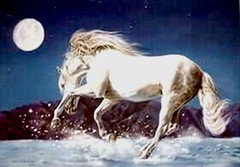
The Pale Horse



